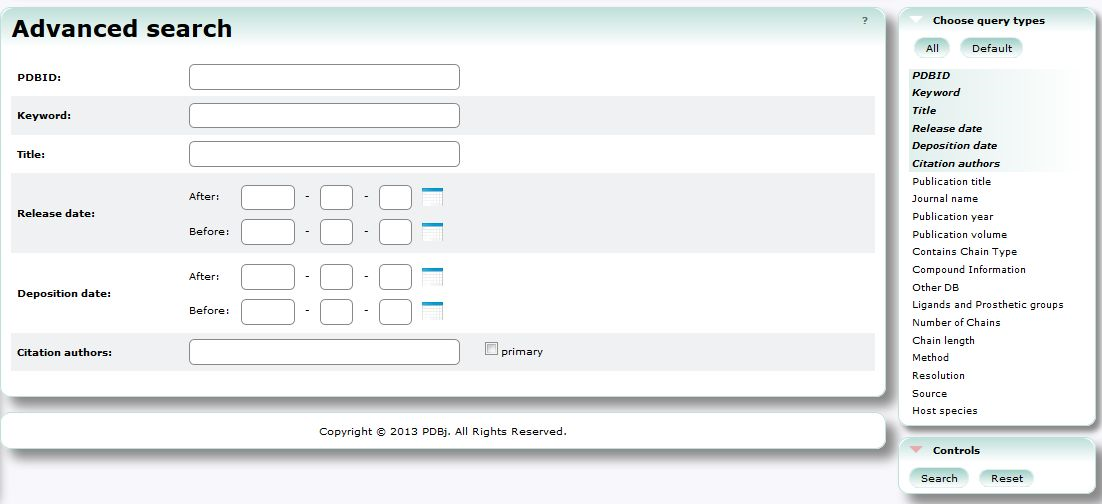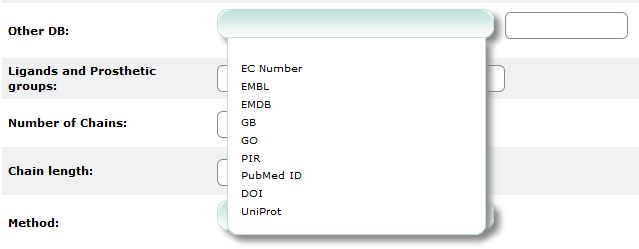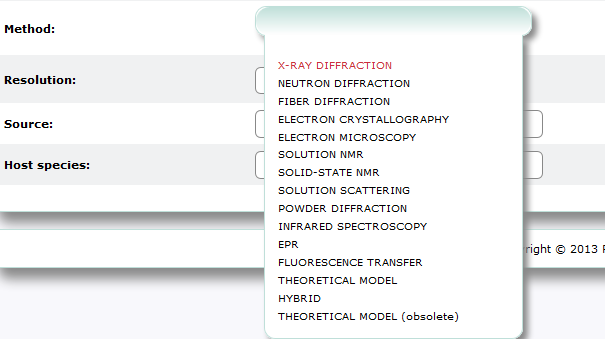Advanced search
URL: https://pdbj.org//advancedSearch

- [PDB ID]
- [Keywords]
- [Title]
- [Release Date、Deposition Date]
- [Citation Author]
- [Journal]
- [Contains Chain Type]
- [Compound Information]
- [Other DB]
- [Ligands and Prosthetic groups]
- [Number of Chains]
- [Chain length]
- [Experimental Technique]
- [Resolution]
- [Source]
- [Host Species]
[PDB ID]

Retrieve structures by PDB ID.
If the PDB ID of an entry is known, enter the ID into the text box next to 'PDB ID'. Wildcard characters can be used to substitute for any part of PDB IDs like the following examples.
- e.g.1) PDB IDs start with1A
-
1A*
- e.g.2) PDB IDs end with4C
-
*4C
- e.g.3) PDB IDs containAC
-
*AC*
When entering a complete PDB ID, the summary page of the entry will be displayed. To search entries which contain a certain PDB ID as other information such as related ID, perform a keywords search.
e.g.)
entering1smdinto 'PDB ID' --The summary page of1smdstructure is displayed
entering1smdinto 'Keywords' --The list of entries, which include1smdsomewhere in the contents, is
displayed
[Keywords]

Search for structures with keywords.
The words entered in the text box are always used as keywords in the Advanced Search.
When used in Mine Quick Search, the words are automatically treated as PDB ID or keywords according to the validity of the words as PDB ID.
[Release Date、Deposition Date]

Search for structures by the range of release date or deposition date.
Enter a start date into the left box next to 'after' and an end date into the right box next to 'before' to find all entries deposited or released between those dates. If you know an exact date, enter the same date into both 'before' and 'after'.
All of 'month', 'day' and 'year' fields shoud be specified when you know a specific year or a month only.
- e.g.) search for January, 2008
-
OK: after January/1/2008 before January/31/2008
NG: after January/ (blank) /2008 before January/ (blank) /2008
[Citation Author]

Search for structures by the name of citation authors.
Enter the name of citation authors into the text box next to 'Citation Author' to a maximum of 3 names. When 'primary citation only!' is checked ON, the search is limited to the primary citation only.
[Journal]

Search for structures by journal information.
The following items can be specified: Title: the title of the citation Name : the name of the journal name Year : the year when the citation was published Volume: the volume of the journal
[Contains Chain Type]

Search for structures based on the chains of certain molecule types.
The type of chains in structures can be specified. Select 'Yes' to include the chain, 'No' to exclude the chain and 'Ignore' to give no restriction.
- Polypeptide(L):polypeptide composed of L-amino acids
- Polypeptide(D):polypeptide composed of D-amino acids
- polydeoxyribonucleotide:DNA chain composed of deoxyribonucleotide
- polyribonucleotide:RNA chain composed of ribonucleotid
- polysaccharide(D):polysaccharide composed of D-monosaccharides
- polysaccharide(L):polysaccharide composed of L-monosaccharides
- polydeoxyribonucleotide/polyribonucleotide hybrid:hybrid of polydeoxyribonucleotide/polyribonucleotide
- cyclic-pseudo-peptide:
- other:
[Compound Information]

Search for structures by compound information.
Enter any compound information in structures into the text box next to 'Compound Information' (e.g. ATP).
[Title]

Search for structures by structure title.
Enter a part of structure title into the text box next to 'Title'.(e.g. mutant).
[Other DB]

Search for structures by the information of external database.
Select a database name from pull-down menu and enter its identification code into text box next to 'ID'.
The following is the list of external database:
- PubMed ID
- EC Number
- GO
- UniProt
- GB
- EMBL
- PIR
[Ligands and Prosthetic groups]

Search for structures by the ligands and prosthetic groups in the structures(e.g.heme).
[Number of Chains]

Search for structures by the number of chains.
[Chain length]

Search for structures by the length of chains.
[Experimental Technique]

Search for structures by the experimental method used to determine the structure.
[Resolution]

Searches for structures in the specified resolution range (unit is Angstrom).
[Source]

Searches for structures by source organism.
In case the molecule was obtained by gene introducing to other organism, the name of gene resource organism is specified. Both the common name, e.g. human, and the scientific name, e.g. Homo sapiens, can be used.
[Host Species]

Searches for structures by the expression host organism.
Both the common name, e.g. mouse, and the scientific name, e.g. Mus musculus, can be used.







